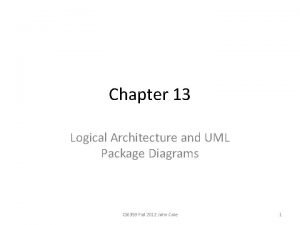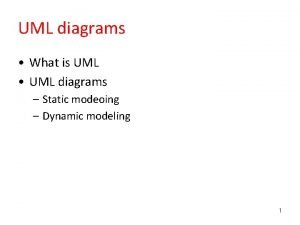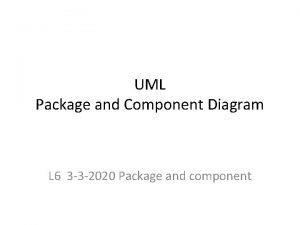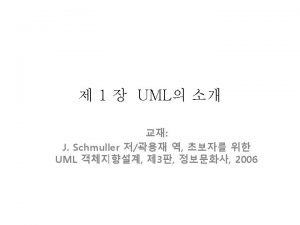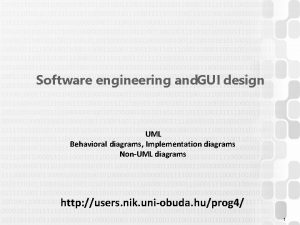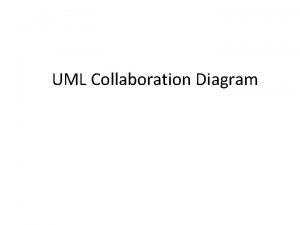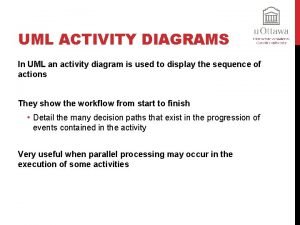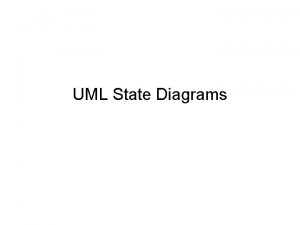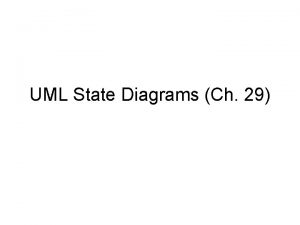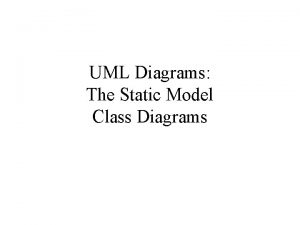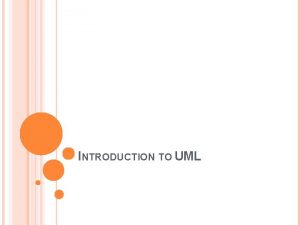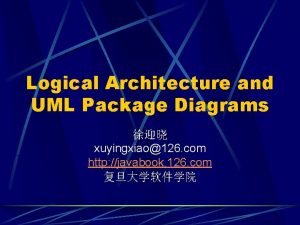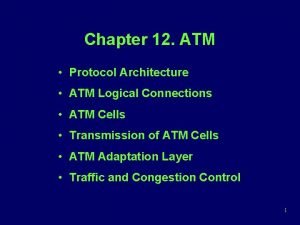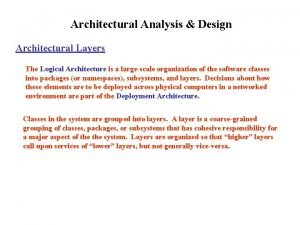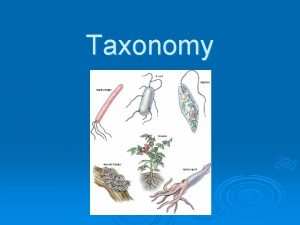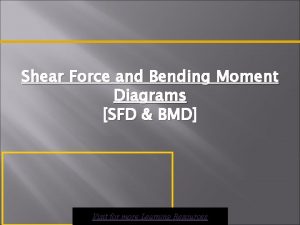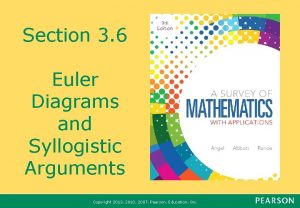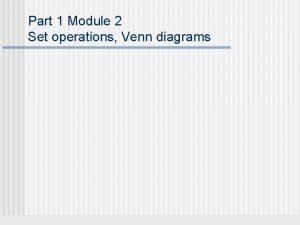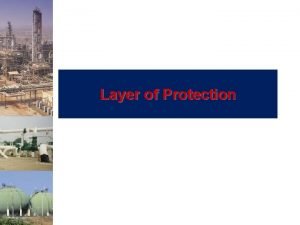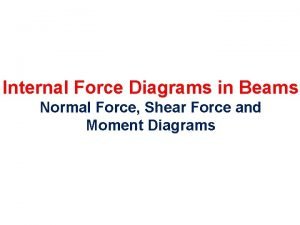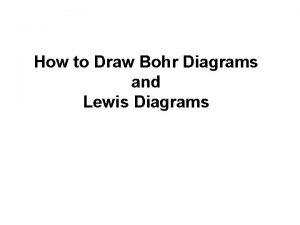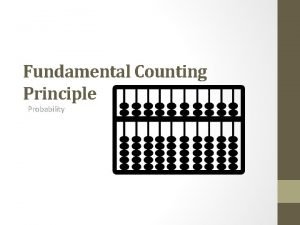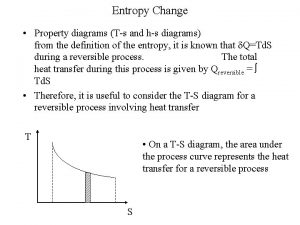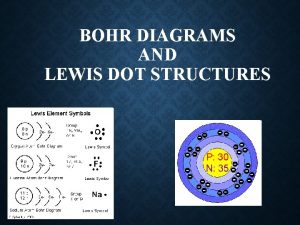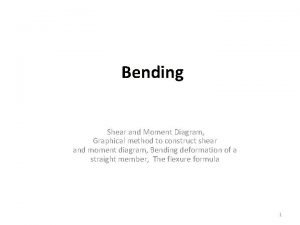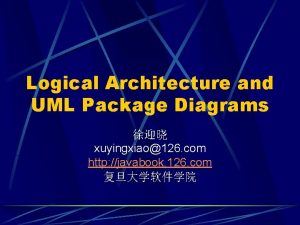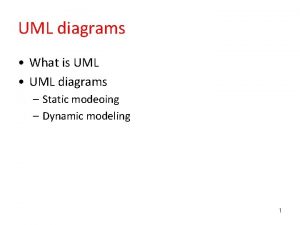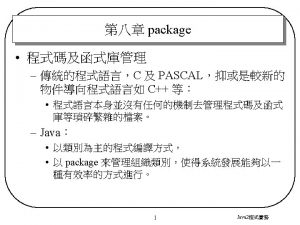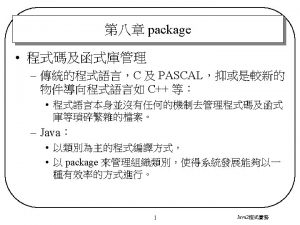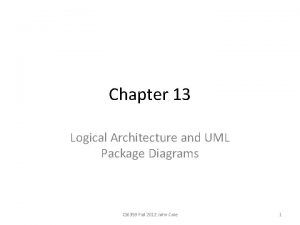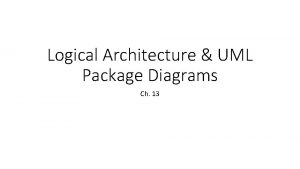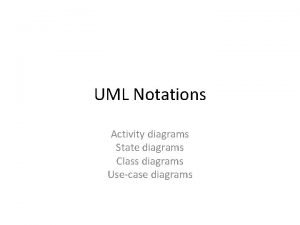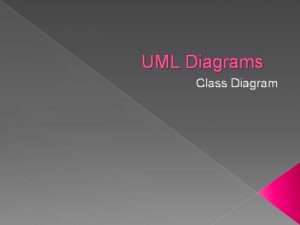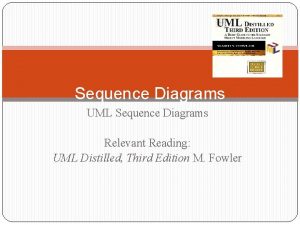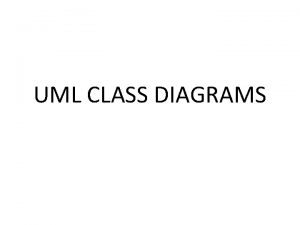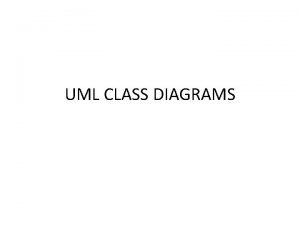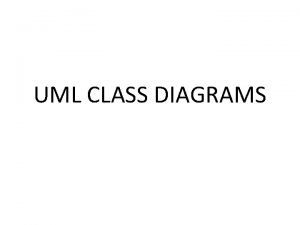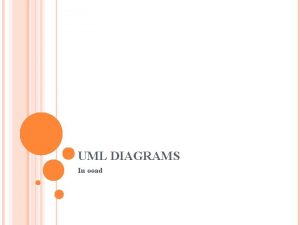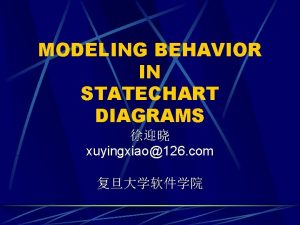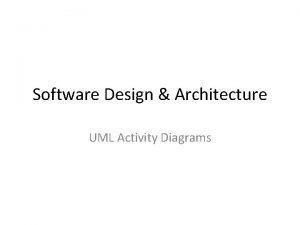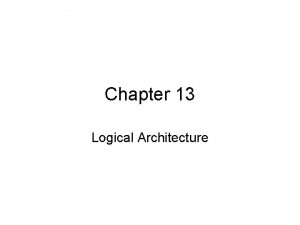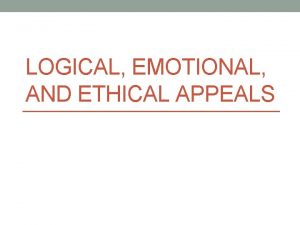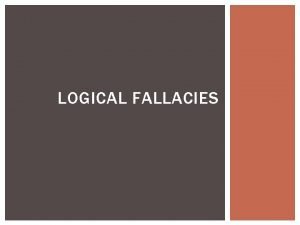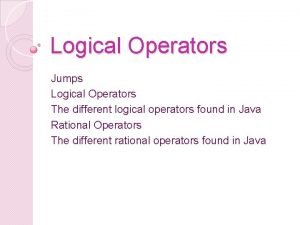Logical Architecture and UML Package Diagrams xuyingxiao126 com


















































- Slides: 50

Logical Architecture and UML Package Diagrams 徐迎晓 xuyingxiao@126. com http: //javabook. 126. com 复旦大学软件学院

Outline Definition Architectural Dimension and Views Architectural Pattern: Layers Package Diagrams Logical vs. Process and Deployment of Architecture Terminology: Tier, Layers, and Partitions How do we design application logic with objects? Domain Layer and Domain Model Information Systems Two-tier Design The Model-View Separation Principle Need for Model-View separation




Architecture metamodel

Outline Definition Architectural Dimension and Views Architectural Pattern: Layers Package Diagrams Logical vs. Process and Deployment of Architecture Terminology: Tier, Layers, and Partitions How do we design application logic with objects? Domain Layer and Domain Model Information Systems Two-tier Design The Model-View Separation Principle Need for Model-View separation

Definition Software Architecture: large scale-the Big Ideas in the forces, organization, styles, patterns, responsibilities, collaborations, connections and motivations of a system and major subsystems.


Fig. 13. 3

Definition variance noun l the architecture includes the organization and structure of the major elements of the system. verb l architecture is part investigation and part design work.

Definition Architectural investigation: involves functional and non-functional requirements that have impact on system design. l Some of these are: Market trends, performance, cost and points of evolution. Architectural Design: is the resolution of these requirements in the design of software.

Outline Definition Architectural Dimension and Views Architectural Pattern: Layers Package Diagrams Logical vs. Process and Deployment of Architecture Terminology: Tier, Layers, and Partitions How do we design application logic with objects? Domain Layer and Domain Model Information Systems Two-tier Design The Model-View Separation Principle Need for Model-View separation

Architectural Dimension and Views in UP The common dimensions are: l l The logical architecture, describes the system in terms of its conceptual organization in layers, packages, classes, interfaces and subsystems. The deployment architecture, describes the system in terms of the allocation of process to processing unit and network configurations.

Architecture Dimensions and Views Logical View Implementation View Use-Case View Process View Deployment View

Outline Definition Architectural Dimension and Views Architectural Pattern: Layers Package Diagrams Logical vs. Process and Deployment of Architecture Terminology: Tier, Layers, and Partitions How do we design application logic with objects? Domain Layer and Domain Model Information Systems Two-tier Design The Model-View Separation Principle Need for Model-View separation

Architectural Pattern: Layers


What is a layer? “A layer is a coarse grained grouping of classes packages or subsystems that has cohesive responsibility for a major aspect of the system. ” Higher layers call upon the services of lower layers.

Architectural Patterns and Pattern Categories Architectural patterns: Relates to large-scale design and typically applied during the early iterations(in elaboration phase). Design patterns: Relates to small and mediumscale design of objects and frameworks. Idioms: Relates to language or implementationoriented low-level design solutions.

Architectural Pattern: Layers Idea behind Layer patterns: l Organize the large-scale logical structure of a system into discrete layers of distinct, related responsibilities with a clean, cohesive separation of concerns such that the “lower” layers are low-level and general services, and the higher layers are more application specific. l Collaboration and coupling is from higher to lower layers.

Inter-Layer and Inter. Package Coupling It is informative to include a diagram in the logical view that shows the coupling between the layers and packages. Following figure shows the coupling.

Partial coupling between Packages


Inter-Layer and Inter. Package Interaction Emphasizes the dynamics of how objects across the layers connect and communicate. The interaction diagram focuses on the logical view and on the collaborations between the layers and package boundaries.

Outline Definition Architectural Dimension and Views Architectural Pattern: Layers Package Diagrams Logical vs. Process and Deployment of Architecture Terminology: Tier, Layers, and Partitions How do we design application logic with objects? Domain Layer and Domain Model Information Systems Two-tier Design The Model-View Separation Principle Need for Model-View separation

Package Diagrams UML Package Diagrams are often used to show the contents of components, which are often packages in the Java sense. Each package represents a namespace. Packages, as components, can be nested inside other packages.

Package Diagram UI Domain Swing Web Sales

Outline Definition Architectural Dimension and Views Architectural Pattern: Layers Package Diagrams Logical vs. Process and Deployment of Architecture Terminology: Tier, Layers, and Partitions How do we design application logic with objects? Domain Layer and Domain Model Information Systems Two-tier Design The Model-View Separation Principle Need for Model-View separation

Logical vs. Process and Deployment of Architecture Architectural Layers are a logical view of the architecture They are not a deployment view of elements to process. Depending on platform, all layers could be deployed within the same process on same node. Or across many computers.

Outline Definition Architectural Dimension and Views Architectural Pattern: Layers Package Diagrams Logical vs. Process and Deployment of Architecture Terminology: Tier, Layers, and Partitions How do we design application logic with objects? Domain Layer and Domain Model Information Systems Two-tier Design The Model-View Separation Principle Need for Model-View separation

Terminology: Tier, Layers, and Partitions Tier relates to physical processing node or clusters of node, such as “client tier”. Layers of an architecture represent the vertical slices Partitions represents a horizontal division of relatively parallel subsystems of a layer.

Fig. 13. 6 Layers and Partitions Copyright © 2004 Glenn L. Ray (From Larman 2004)

Outline Definition Architectural Dimension and Views Architectural Pattern: Layers Package Diagrams Logical vs. Process and Deployment of Architecture Terminology: Tier, Layers, and Partitions How do we design application logic with objects? Domain Layer and Domain Model Information Systems Two-tier Design The Model-View Separation Principle Need for Model-View separation

How do we design application logic with objects? We could create one class and put all logic in it, but that violates the whole spirit of object orientation. We create software objects with names drawn from the real world, and assign application logic responsibilities to them. It takes a lot of skill and experience to do a good job of choosing objects and assigning responsibilities.

Outline Definition Architectural Dimension and Views Architectural Pattern: Layers Package Diagrams Logical vs. Process and Deployment of Architecture Terminology: Tier, Layers, and Partitions How do we design application logic with objects? Domain Layer and Domain Model Information Systems Two-tier Design The Model-View Separation Principle Need for Model-View separation

Domain Layer and Domain Model These are not the same thing. Domain model shows the real world, while the Domain layer shows the software architecture. But the Domain model inspires the Domain layer, and is the source of many of the concept, especially class names. Do not confuse the problem with the solution.

Fig. 13. 8

Outline Definition Architectural Dimension and Views Architectural Pattern: Layers Package Diagrams Logical vs. Process and Deployment of Architecture Terminology: Tier, Layers, and Partitions How do we design application logic with objects? Domain Layer and Domain Model Information Systems Two-tier Design The Model-View Separation Principle Need for Model-View separation

Information Systems In IS layered architecture was known as three-tier architecture. A three-tier architecture has interface, Application logic and a storage. The singular quality of 3 -tier architecture is: l l Separation of the application logic into distinct logical middle tier of software. The interface tier is relatively free of application processing.

Information Systems(cont. . ) The middle tier communicates with the back-end storage layer. The following is an example of 3 -tier architecture.

Example:


Outline Definition Architectural Dimension and Views Architectural Pattern: Layers Package Diagrams Logical vs. Process and Deployment of Architecture Terminology: Tier, Layers, and Partitions How do we design application logic with objects? Domain Layer and Domain Model Information Systems Two-tier Design The Model-View Separation Principle Need for Model-View separation

Two-tier Design In this design, the application logic is placed within window definitions, which read and writes directly to database. There is no middle tier that separates out the application logic.

Outline Definition Architectural Dimension and Views Architectural Pattern: Layers Package Diagrams Logical vs. Process and Deployment of Architecture Terminology: Tier, Layers, and Partitions How do we design application logic with objects? Domain Layer and Domain Model Information Systems Two-tier Design The Model-View Separation Principle Need for Model-View separation

The Model-View Separation Principle The principle states that model(domain) objects should not have direct knowledge of view(presentation) objects. Furthermore, the domain classes should encapsulate the information and behavior related to application logic.

Outline Definition Architectural Dimension and Views Architectural Pattern: Layers Package Diagrams Logical vs. Process and Deployment of Architecture Terminology: Tier, Layers, and Partitions How do we design application logic with objects? Domain Layer and Domain Model Information Systems Two-tier Design The Model-View Separation Principle Need for Model-View separation

Need for Model-View separation To support cohesive model definitions that focus on the domain process, rather than on interfaces. To allow separate development of the model and user interface layers. To minimize the impact of requirements changes in the interface upon the domain layer. To allow new views to be easily connected to an existing domain layer, without affecting the domain layer.

Continue. . To allow multiple simultaneous views on the same model object. To allow execution of the model layer independent of the user interface layer To allow easy porting of the model layer to another user interface framework.
 Logical architecture and uml package diagram
Logical architecture and uml package diagram Bài thơ mẹ đi làm từ sáng sớm
Bài thơ mẹ đi làm từ sáng sớm Cơm
Cơm Apa itu uml
Apa itu uml Game use case diagram
Game use case diagram Class diagram
Class diagram Explain uml package diagram
Explain uml package diagram Uml-diagrams.org
Uml-diagrams.org Logical form
Logical form Logical form and logical equivalence
Logical form and logical equivalence The interaction diagrams, use case diagrams are called as
The interaction diagrams, use case diagrams are called as Activity diagram if
Activity diagram if Analysis model uml
Analysis model uml Behavioral diagrams
Behavioral diagrams Collaboration diagram example
Collaboration diagram example Activity chart diagram
Activity chart diagram Introduction for gym website
Introduction for gym website Pos uml diagrams
Pos uml diagrams State diagrams uml
State diagrams uml Pos uml diagrams
Pos uml diagrams What are the building blocks of uml
What are the building blocks of uml Static in uml
Static in uml Structural view in uml
Structural view in uml Logical view uml
Logical view uml Uml2.0
Uml2.0 Atm cont
Atm cont Wmlscript
Wmlscript Logical architecture example
Logical architecture example Wta logical architecture
Wta logical architecture Call and return architecture in software architecture
Call and return architecture in software architecture Recarbrio package insert
Recarbrio package insert Cycle
Cycle What is product architecture
What is product architecture Fundamental and incidental interactions
Fundamental and incidental interactions 3 bus architecture
3 bus architecture The grouping of objects based on similarities
The grouping of objects based on similarities Sfd diagram
Sfd diagram Euler diagram examples valid or invalid
Euler diagram examples valid or invalid Health concerns
Health concerns Set operations and venn diagrams
Set operations and venn diagrams Piping and instrumentation diagrams
Piping and instrumentation diagrams Shear and moment diagram examples
Shear and moment diagram examples Bohr rutherford diagrams for the first 20 elements
Bohr rutherford diagrams for the first 20 elements Tree diagram and fundamental counting principle
Tree diagram and fundamental counting principle Allppt.com template
Allppt.com template Allppt com free powerpoint templates
Allppt com free powerpoint templates Ts and hs diagrams
Ts and hs diagrams How to draw aoa network diagram
How to draw aoa network diagram Chapter 21 wiring diagrams and wiring repairs
Chapter 21 wiring diagrams and wiring repairs Review bohr and lewis dot diagrams
Review bohr and lewis dot diagrams Bending stress formula
Bending stress formula
